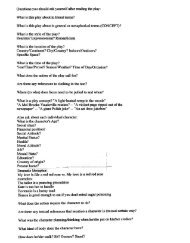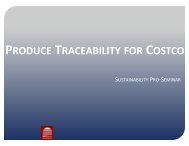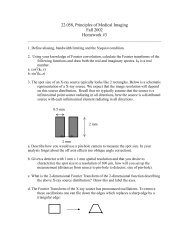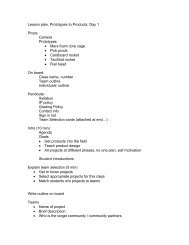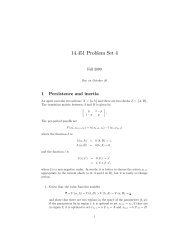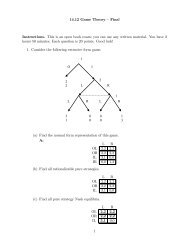14.41 Problem Set #3 Due Friday, Oct. 29 , at 1PM 1) Consider a ...
14.41 Problem Set #3 Due Friday, Oct. 29 , at 1PM 1) Consider a ...
14.41 Problem Set #3 Due Friday, Oct. 29 , at 1PM 1) Consider a ...
- No tags were found...
You also want an ePaper? Increase the reach of your titles
YUMPU automatically turns print PDFs into web optimized ePapers that Google loves.
2) In January, you are hired to help the presidential adminstr<strong>at</strong>ion set its agenda for the<br />
2005-2009 term. You are asked to review the Unemployment Insurance (UI) program,<br />
which currently replaces approxim<strong>at</strong>ely 45% of a worker’s wages for 26 weeks after she<br />
loses her job. Answer each part of the question in 1-2 paragraphs.<br />
President X’s labor secretary shows you a table comparing the unemployment dur<strong>at</strong>ions<br />
of individuals who receive UI and do not receive UI. This table reveals th<strong>at</strong> those who<br />
receive UI stay unemployed longer than those th<strong>at</strong> do not receive UI. He claims th<strong>at</strong> this<br />
proves th<strong>at</strong> UI causes longer unemployment dur<strong>at</strong>ions.<br />
a) Is he correct? Why or why not? Wh<strong>at</strong> other evidence could you bring to bear on this<br />
question th<strong>at</strong> might be more useful in gleaning the correct rel<strong>at</strong>ionship between UI<br />
generosity and unemployment dur<strong>at</strong>ions?<br />
b) If UI causes longer unemployment dur<strong>at</strong>ions, does this prove th<strong>at</strong> the generosity of the<br />
program should be reduced? Why or why not?<br />
c) <strong>Consider</strong> two altern<strong>at</strong>ive reforms of the current UI system. The first is to perfectly<br />
experience r<strong>at</strong>e firms, so th<strong>at</strong> the taxes th<strong>at</strong> firms pay are set exactly equal to the benefits<br />
their workers receive (benefits remain <strong>at</strong> 45% of wages). The second is a system of<br />
individual perfect experience r<strong>at</strong>ing - the government would loan individuals 45% of their<br />
wages while unemployed, but they would have to pay them back when they get a new<br />
job.<br />
(i) Contrast the effects of these altern<strong>at</strong>ive policies on unemployment dur<strong>at</strong>ions and the<br />
likelihood of worker layoffs.<br />
(ii) Contrast the extent of insurance for workers provided by each of these altern<strong>at</strong>ives<br />
with the current system.
3) Having done such a gre<strong>at</strong> job analyzing UI, you are now asked to help reform the<br />
Disability Insurance (DI) system, which provides benefits for the rest of your life for offthe-job<br />
injuries which leave you unable to work. In particular, it is considering two<br />
altern<strong>at</strong>ive reforms:<br />
1. Paying different DI benefits for different types of disabilities (e.g. you get<br />
30% of your previous wage if you have disability type X and 50% if you have<br />
disability type Y).<br />
2. Increasing the length of time people must have gone without working before<br />
they are allowed to apply from 5 months to 12 months.<br />
a) Explain the r<strong>at</strong>ionale behind each proposal.<br />
b) Explain the downside of each proposal.<br />
c) If you recommend reform #1, how would you decide which type of injuries<br />
should get higher compens<strong>at</strong>ion and which type should get lower compens<strong>at</strong>ion?
4) In H<strong>at</strong>chetville, workers earn a wage of 9. They have a 5% chance of injury on the job,<br />
but the injuries differ in severity—the pain P while working th<strong>at</strong> results from the injury is<br />
an element of (1, 2, …, 10), with a equal 10% probability of each. Workers have utility:<br />
U= 2 / 3 C 3/2 – ½ P 2<br />
where C, consumption, equals the wage if they work and 0 if they do not, and P equals<br />
the pain when they work (if uninjured, P=0) and 0 if they do not. (Assume th<strong>at</strong> if people<br />
are indifferent between working and not working th<strong>at</strong> they do not work).<br />
a) In a world without insurance, <strong>at</strong> wh<strong>at</strong> level of pain will people choose not to<br />
work? Wh<strong>at</strong>, on average, will be the labor force particip<strong>at</strong>ion r<strong>at</strong>e?<br />
b) Wh<strong>at</strong> is the socially optimal level of pain <strong>at</strong> which to not work?<br />
The mayor of H<strong>at</strong>chetville cre<strong>at</strong>es a worker’s compens<strong>at</strong>ion program, in which people<br />
receive compens<strong>at</strong>ion of 3 if they are injured and do not work.<br />
c) At wh<strong>at</strong> level of pain will people choose not to work now? Wh<strong>at</strong> is the new labor<br />
force particip<strong>at</strong>ion r<strong>at</strong>e? Does this increase in the “adverse event” (not working<br />
due to injury) increase or decrease social welfare? Why?<br />
A new mayor takes office who thinks th<strong>at</strong> the compens<strong>at</strong>ion is too low—after all,<br />
workers only receive 1/3 of their former wage! He proposes instead a payment of 5.<br />
d) At wh<strong>at</strong> level of pain will people choose not to work now? Wh<strong>at</strong> is the new labor<br />
force particip<strong>at</strong>ion r<strong>at</strong>e? Is this increase in the “adverse event” increase or<br />
decrease social welfare? Explain and compare to (c)?




